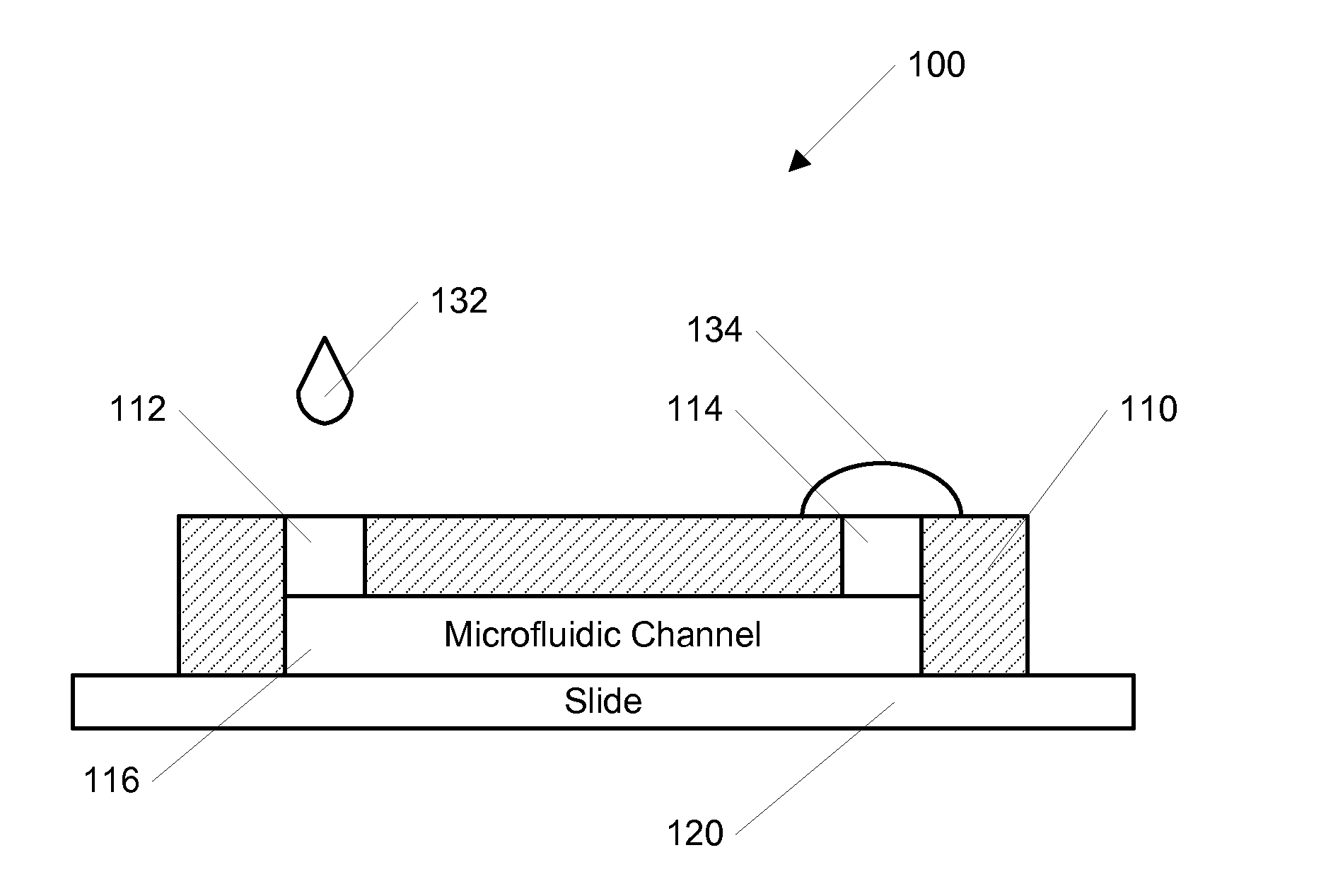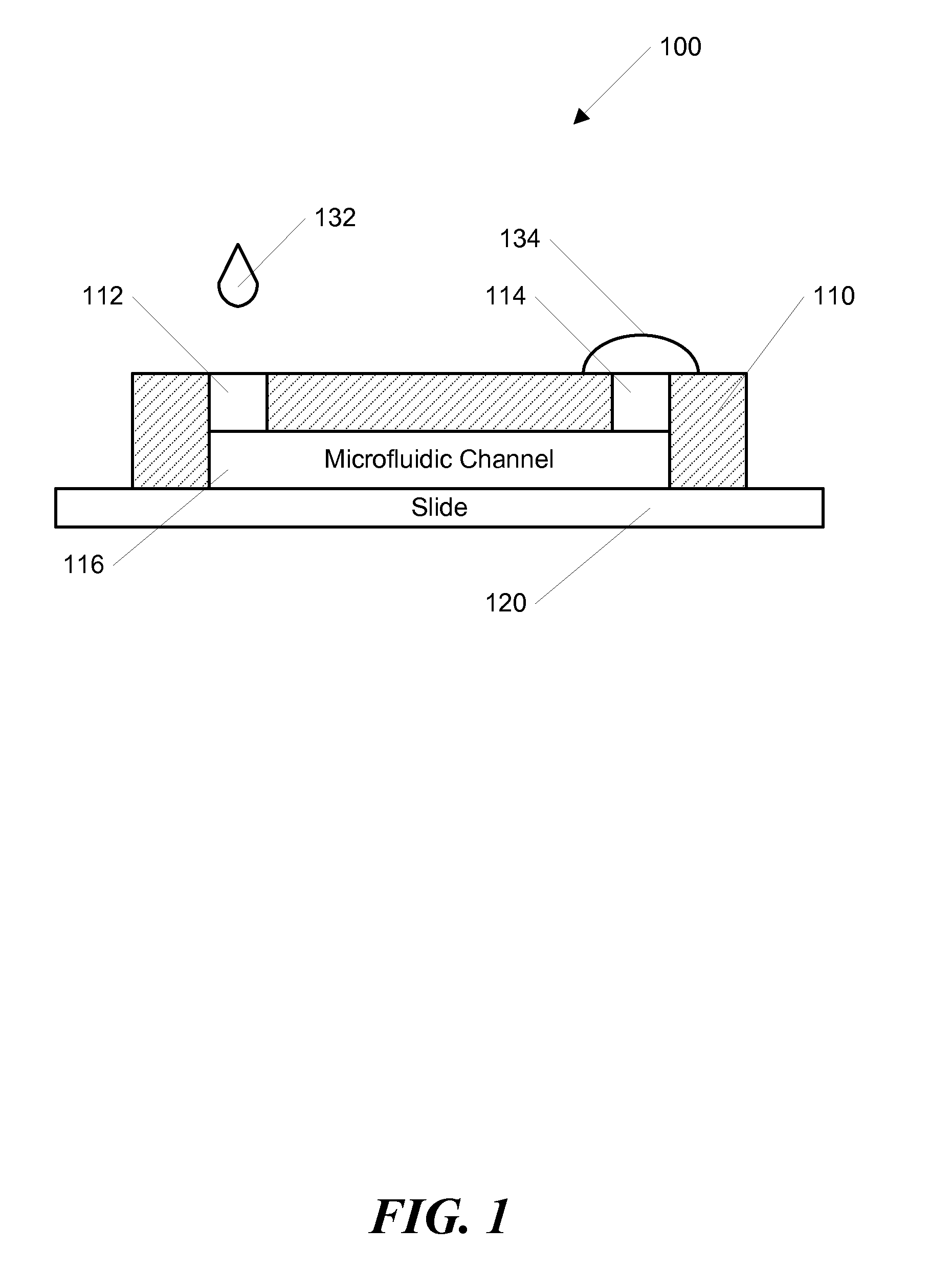Method and system for generating spatially and temporally controllable concentration gradients
a technology of concentration gradient, which is applied in the field of method and system for generating spatial and temporal controllable concentration gradient, can solve the problems of unstable gradient, unstable gradient, and incompatibility of experiments with non-adherent and weakly adherent cells, and achieve the effect of regulating the cellular respons
- Summary
- Abstract
- Description
- Claims
- Application Information
AI Technical Summary
Benefits of technology
Problems solved by technology
Method used
Image
Examples
example 1
[0052]In one example according to the invention, the channel was initially filled with Dulbecco's Phosphate Buffered Saline (DPBS, Gibco, Carlsbad, Calif.). A 200 μL drop of DPBS was pipetted onto the outlet opening and a 2 μL drop of DPBS containing the molecule of interest was dropped onto the inlet opening and subsequently entered the channel automatically. After the small drop entered the channel completely, a second drop containing 2 μL was pipetted onto the inlet to continue the forward flow. When the inlet was not refilled, the forward flow would stop and a backflow occurred due to evaporation at the room humidity (˜65%). To visualize the dynamic process of the concentration gradient generation, fluorescein isothiocyanate-dextran (FITC-Dextran, molecular weight (MW): 10 kD) was used as the model molecule, and the fluorescence image series was captured using a Kodak Gel Logic 100 Imaging System, shown in FIGS. 4-6. The average fluorescence intensity along the whole channel was...
example 2
[0057]In another example, a stable concentration gradient was produced using the process shown in FIG. 3. As described above, FIG. 3 shows a schematic diagram of the gradient generation and stabilization process: A) Microfluidic channel was first filled with DPBS; a large drop of DPBS was placed on the outlet opening and a small drop of the gradient material containing diffusible molecules was pipetted on the inlet opening, B) solution was introduced into the channel automatically by the passive-pump-induced forward-flow; C) a concentration gradient of molecules was generated during the evaporation-based backward flow; D) the gradient profile could be stabilized by stopping the evaporation, either by sealing the inlet with mineral oil or by maintaining the microfluidic device at 100% humidity.
[0058]In this example, the microfluidic channel was initially filled with DPBS, and a 200 μL drop of DPBS was pipetted onto the outlet. A small drop of 2 μL DPBS containing FITC-Dextran was the...
example 3
Stabilized Concentration Gradient for Cytotoxicity Testing
[0064]In this example, the stabilized, spatially and temporally controllable concentration gradient technique is utilized for cytotoxicity testing. A cardiac muscle cell line (HL-1) is used to investigate the cytotoxicity of Alpha-cypermethrin, a cardiac toxin. Three drops of 2 μL medium containing 20 mM Alpha-cypermethrin were loaded consecutively into the micro-devices with HL-1 cells seeded along the channel. A concentration gradient of the toxin was established by evaporation when the micro device was left at ambient conditions for 5 min (5 min exposure does not cause severe damage to cell viability) and the gradient was stabilized when the micro device was transferred to the humidified incubator. HL-1 cells exposed to the toxin concentration gradient for 4 h exhibited distinguishable morphologies along the channel, with more severe effects observed in the regions containing higher concentrations of toxin. The drastic mor...
PUM
 Login to View More
Login to View More Abstract
Description
Claims
Application Information
 Login to View More
Login to View More - Generate Ideas
- Intellectual Property
- Life Sciences
- Materials
- Tech Scout
- Unparalleled Data Quality
- Higher Quality Content
- 60% Fewer Hallucinations
Browse by: Latest US Patents, China's latest patents, Technical Efficacy Thesaurus, Application Domain, Technology Topic, Popular Technical Reports.
© 2025 PatSnap. All rights reserved.Legal|Privacy policy|Modern Slavery Act Transparency Statement|Sitemap|About US| Contact US: help@patsnap.com



